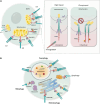Selective autophagy as a therapeutic target for neurological diseases
- PMID: 33067655
- PMCID: PMC7904548
- DOI: 10.1007/s00018-020-03667-9
Selective autophagy as a therapeutic target for neurological diseases
Abstract
The neurological diseases primarily include acute injuries, chronic neurodegeneration, and others (e.g., infectious diseases of the central nervous system). Autophagy is a housekeeping process responsible for the bulk degradation of misfolded protein aggregates and damaged organelles through the lysosomal machinery. Recent studies have suggested that autophagy, particularly selective autophagy, such as mitophagy, pexophagy, ER-phagy, ribophagy, lipophagy, etc., is closely implicated in neurological diseases. These forms of selective autophagy are controlled by a group of important proteins, including PTEN-induced kinase 1 (PINK1), Parkin, p62, optineurin (OPTN), neighbor of BRCA1 gene 1 (NBR1), and nuclear fragile X mental retardation-interacting protein 1 (NUFIP1). This review highlights the characteristics and underlying mechanisms of different types of selective autophagy, and their implications in various forms of neurological diseases.
Keywords: Alzheimer’s disease; Autophagy receptor; Macroautophagy; Neuroprotection; Parkinson’s disease; Stroke.
Conflict of interest statement
The authors state that there was no conflict of interest in the preparation of this review.
Figures


Similar articles
-
PRKN-regulated mitophagy and cellular senescence during COPD pathogenesis.Autophagy. 2019 Mar;15(3):510-526. doi: 10.1080/15548627.2018.1532259. Epub 2018 Oct 13. Autophagy. 2019. PMID: 30290714 Free PMC article.
-
Selective autophagy of intracellular organelles: recent research advances.Theranostics. 2021 Jan 1;11(1):222-256. doi: 10.7150/thno.49860. eCollection 2021. Theranostics. 2021. PMID: 33391472 Free PMC article.
-
The ICP0 Protein of Herpes Simplex Virus 1 (HSV-1) Downregulates Major Autophagy Adaptor Proteins Sequestosome 1 and Optineurin during the Early Stages of HSV-1 Infection.J Virol. 2019 Oct 15;93(21):e01258-19. doi: 10.1128/JVI.01258-19. Print 2019 Nov 1. J Virol. 2019. PMID: 31375597 Free PMC article.
-
Mechanisms of selective autophagy and mitophagy: Implications for neurodegenerative diseases.Neurobiol Dis. 2019 Feb;122:23-34. doi: 10.1016/j.nbd.2018.07.015. Epub 2018 Jul 17. Neurobiol Dis. 2019. PMID: 30030024 Free PMC article. Review.
-
Dynamic recruitment and activation of ALS-associated TBK1 with its target optineurin are required for efficient mitophagy.Proc Natl Acad Sci U S A. 2016 Jun 14;113(24):E3349-58. doi: 10.1073/pnas.1523810113. Epub 2016 May 31. Proc Natl Acad Sci U S A. 2016. PMID: 27247382 Free PMC article.
Cited by
-
Role of Mitophagy in the Pathogenesis of Stroke: From Mechanism to Therapy.Oxid Med Cell Longev. 2022 Feb 27;2022:6232902. doi: 10.1155/2022/6232902. eCollection 2022. Oxid Med Cell Longev. 2022. PMID: 35265262 Free PMC article. Review.
-
Autophagy regulates inflammation in intracerebral hemorrhage: Enemy or friend?Front Cell Neurosci. 2023 Jan 16;16:1036313. doi: 10.3389/fncel.2022.1036313. eCollection 2022. Front Cell Neurosci. 2023. PMID: 36726453 Free PMC article. Review.
-
A Diagnostic Model for Alzheimer's Disease Based on Blood Levels of Autophagy-Related Genes.Front Aging Neurosci. 2022 May 12;14:881890. doi: 10.3389/fnagi.2022.881890. eCollection 2022. Front Aging Neurosci. 2022. PMID: 35645767 Free PMC article.
-
The Multiple Roles of Autophagy in Neural Function and Diseases.Neurosci Bull. 2024 Mar;40(3):363-382. doi: 10.1007/s12264-023-01120-y. Epub 2023 Oct 19. Neurosci Bull. 2024. PMID: 37856037 Free PMC article. Review.
-
Autophagy and Alzheimer's Disease: Mechanisms and Impact Beyond the Brain.Cells. 2025 Jun 16;14(12):911. doi: 10.3390/cells14120911. Cells. 2025. PMID: 40558538 Free PMC article. Review.
References
-
- Chrousos GP, Gold PW. The concepts of stress and stress system disorders. Overview of physical and behavioral homeostasis. JAMA. 1992;267(9):1244–1252. - PubMed
-
- Corrigan JD, Selassie AW, Orman JA. The epidemiology of traumatic brain injury. J Head Trauma Rehabil. 2010;25(2):72–80. - PubMed
-
- Mayeux R. Epidemiology of neurodegeneration. Annu Rev Neurosci. 2003;26:81–104. - PubMed
-
- Bramlett HM, Dietrich WD. Pathophysiology of cerebral ischemia and brain trauma: similarities and differences. J Cereb Blood Flow Metab. 2004;24(2):133–150. - PubMed
-
- Bossy-Wetzel E, Schwarzenbacher R, Lipton SA. Molecular pathways to neurodegeneration. Nat Med. 2004;10(Suppl):S2–S9. - PubMed
Publication types
MeSH terms
Substances
Grants and funding
LinkOut - more resources
Full Text Sources
Medical
Research Materials
Miscellaneous

